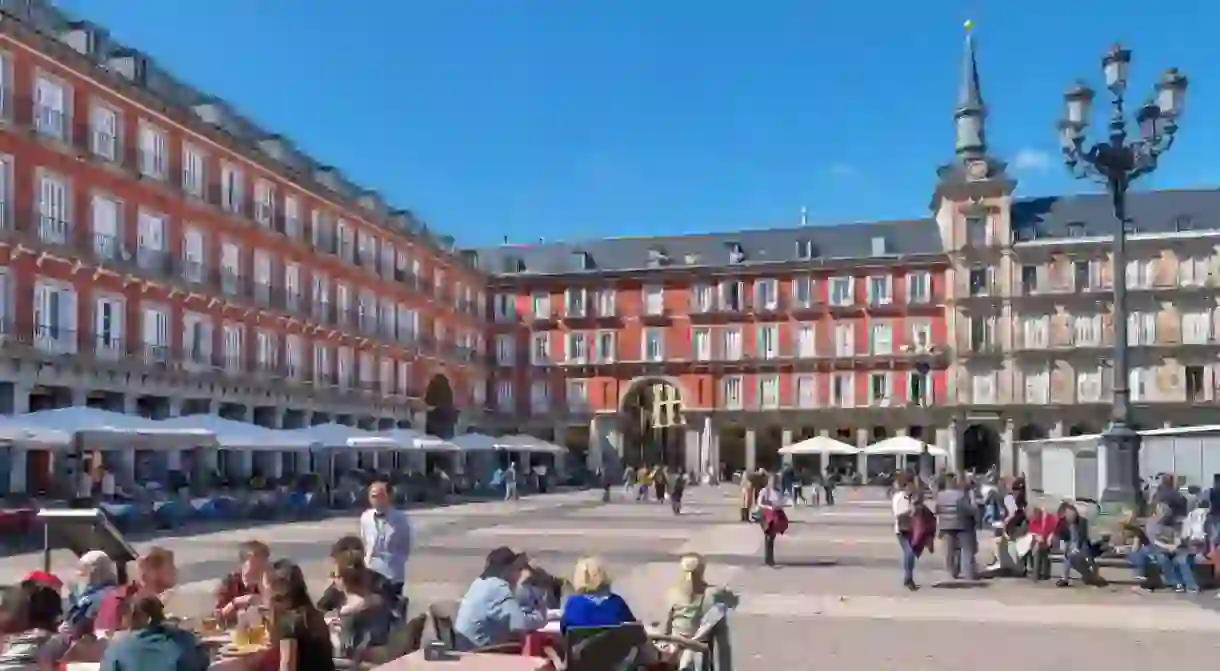A Tour of Madrid’s Architectural Landmarks

Take a stroll through the heat-soaked streets of Spain’s capital, and chances are you’ll discover architecture from a wealth of different eras. From 18th-century gates and Art Nouveau residences to industrial redesigns and Beaux Arts beauties, Madrid knows how to grab the attention of architecture fans, whatever style you prefer.
Museo Nacional Centro de Arte Reina Sofía
Museum

Puerta de Alcalá
Architectural Landmark

This Neoclassical monument is known as the first modern post-Roman triumphal arch that was built in Europe. The gate used to be the entrance to the walled city of Madrid, though the one you can see today wasn’t the first Door of Alcalá. A smaller, less grand version was located closer to the city centre in the 1500s. King Carlos III insisted that a new door be built when he came into power, and in 1764 the original Puerta de Alcalá was torn down and construction began on the new arch. The Puerta de Alcalá that stands today was completed in 1769 and was officially inaugurated in 1778.
Palacio de Longoria
Architectural Landmark

Inspired by French Art Nouveau architecture, the imposing Palacio de Longoria is located in the Malasaña district. It was originally the family home of financier Javier González Longoria, but has been the central headquarters of the SGAE (Spanish Society of Authors and Publishers) since 1950. The palace is not usually open to the public, but you can book tours to experience the interior with its imperial staircase and ornate design.
Edificio Metrópolis
Architectural Landmark, Building

This stunning landmark building, one of the most iconic in Madrid, sits on the corner of Alcalá Street and the famous Gran Vía Street. Designed by Jules and Raymond Février in 1907, the building is owned by insurance company Metrópolis Seguros, hence the name. Among the Edificio Metrópolis’s most notable features are the statues on the rounded top, and the 30,000 leaves of 24-carat gold that cover the tower. Chances are you’ll recognise its beautiful Beaux Arts architecture – it’s one of the most photographed buildings in the city.
Plaza Mayor
Historical Landmark, Architectural Landmark

The Plaza Mayor was originally designed by architect Juan de Herrera and completed in 1619, but plagued by a series of fires that led to it being rebuilt several times. The first struck in 1631, and afterwards, the plaza was reconstructed by Juan Gómez de Mora. The second fire was in 1670; the plaza was then reconstructed by Tomás Román. After a third fire in 1790, the building you see today was created by Juan de Villanueva. The construction took years, and was finally finished in 1854, by which time Juan de Villanueva had passed away. The process was completed by his students Antonio López Aguado and Custodio Moreno.
CaixaForum
Architectural Landmark

In the early 2000s, after designing Tate Modern in London, architects Herzog & de Meuron took on the job of creating a new cultural centre for Madrid, the CaixaForum. The architects demolished a gas station located on the site, which faces the Paseo del Prado and the Royal Botanical Garden, but kept the Central Eléctrica Power Station. The classified red brick shell of the power station remains intact but its base was removed, which opened up for a public plaza underneath the building and creates the impression that it’s floating. The rusted iron used for the top floors gives the mind-boggling building plenty of textural interest, and a “living” wall next to it contrasts nicely with the industrial materials.
Palacio de Cibeles, Plaza Cibeles
Building, Architectural Landmark

KIO Towers
Architectural Landmark

The Madrid skyline is remarkably low-rise for a capital city, which makes the two leaning skyscrapers at the Plaza de Castilla roundabout all the more striking. In 1996, architects Philip Johnson and John Burgee designed each of the KIO Towers at a 15-degree angle in order to avoid hitting the subway below. The 115-metre-high (374-foot-high) towers, named Puerta de Europa I and II – the Door to Europe, in contrast to the Door of Alcalá – were the world’s first inclined skyscrapers and are still an impressive part of the Madrid skyline, which now has plenty of other high-rises.













